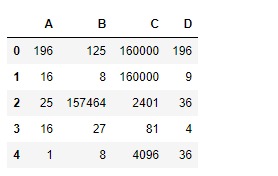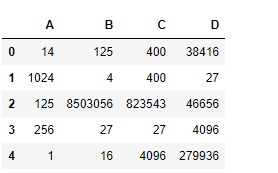Python是进行数据分析的一种出色语言,主要是因为以数据为中心的python软件包具有奇妙的生态系统。 Pandas是其中的一种,使导入和分析数据更加容易。
Pandas dataframe.pow()函数计算数据帧和其他逐元素(二进制运算符pow)的指数幂。此函数与dataframe ** other但支持将缺失值填充到输入数据之一中。
用法: DataFrame.pow(other, axis=’columns’, level=None, fill_value=None)
参数:
other:系列,DataFrame或常量
axis:对于系列输入,轴与系列索引匹配
level:在一个级别上广播,在传递的MultiIndex级别上匹配索引值
fill_value:在计算之前,请使用此值填充现有的缺失(NaN)值以及成功完成DataFrame对齐所需的任何新元素。如果两个对应的DataFrame位置中的数据均丢失,则结果将丢失。
** kwargs:其他关键字参数将传递到DataFrame.shift或Series.shift中。
返回:结果:DataFrame
范例1:采用pow()函数查找数据帧中每个元素的功效。使用一系列将连续的每个元素提高到不同的幂。
# importing pandas as pd
import pandas as pd
# Creating the dataframe
df1 = pd.DataFrame({"A":[14, 4, 5, 4, 1],
"B":[5, 2, 54, 3, 2],
"C":[20, 20, 7, 3, 8],
"D":[14, 3, 6, 2, 6]})
# Print the dataframe
df
让我们创建一个系列
# importing pandas as pd
import pandas as pd
# Create the Series
sr = pd.Series([2, 3, 4, 2], index =["A", "B", "C", "D"])
# Print the series
sr
现在,让我们使用dataframe.pow()函数将连续的每个元素提升为不同的功率。
# find the power
df.pow(sr, axis = 1)输出:

范例2:采用pow()用于将第一数据帧的每个元素提升到另一个数据帧中的相应元素的幂的函数。
# importing pandas as pd
import pandas as pd
# Creating the first dataframe
df1 = pd.DataFrame({"A":[14, 4, 5, 4, 1],
"B":[5, 2, 54, 3, 2],
"C":[20, 20, 7, 3, 8],
"D":[14, 3, 6, 2, 6]})
# Creating the second dataframe
df2 = pd.DataFrame({"A":[1, 5, 3, 4, 2],
"B":[3, 2, 4, 3, 4],
"C":[2, 2, 7, 3, 4],
"D":[4, 3, 6, 12, 7]})
# using pow() function to raise each element
# in df1 to the power of corresponding element in df2
df1.pow(df2)输出:

相关用法
- Python pandas.map()用法及代码示例
- Python Pandas Series.str.len()用法及代码示例
- Python Pandas.factorize()用法及代码示例
- Python Pandas TimedeltaIndex.name用法及代码示例
- Python Pandas dataframe.ne()用法及代码示例
- Python Pandas Series.between()用法及代码示例
- Python Pandas DataFrame.where()用法及代码示例
- Python Pandas Series.add()用法及代码示例
- Python Pandas.pivot_table()用法及代码示例
- Python Pandas Series.mod()用法及代码示例
- Python Pandas Dataframe.at[ ]用法及代码示例
- Python Pandas Dataframe.iat[ ]用法及代码示例
- Python Pandas.pivot()用法及代码示例
- Python Pandas dataframe.mul()用法及代码示例
- Python Pandas.melt()用法及代码示例
注:本文由纯净天空筛选整理自Shubham__Ranjan大神的英文原创作品 Python | Pandas dataframe.pow()。非经特殊声明,原始代码版权归原作者所有,本译文未经允许或授权,请勿转载或复制。
